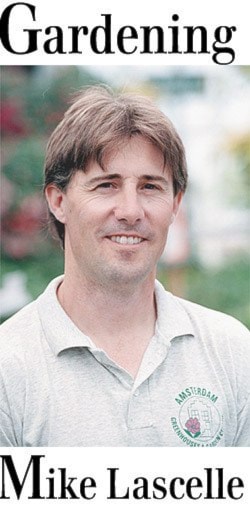Every year, about this time, I have a number of people come into the nursery looking to identify and purchase some of the ornamental grasses that they see growing in our local parks, street plantings and commercial beds.
So this year I thought that I would get a head start on you by perusing downtown Maple Ridge (sorry Pitt Meadows, I promise to feature your gardens down the road) in search of the best looking ornamental grasses – and I have to say, that I wasn’t disappointed, even with the cool weather that we’ve been having up to now.
So here are a few selected grasses with their respected street address (so you can visit them in person), along with a little cultural advice and a few companion plant suggestions.
• Stipa tenuissima/Mexican Feather Grass (Haney Place Mall entrance off 224th Street) – Mexican feather grass embodies movement in the garden, as it flails about with the slightest breeze. Solitary specimens can look great in a large pot, but this species looks best when planted in mass or large drifts which are sculpted every which way by the passing wind. You need a lot of sun (at least five hours) and near-perfect drainage for this Stipa to survive, as it often rots out in wet soils during the winter.
Consider planting with Echinacea ‘Magnus’ or Sedum ‘Purple Emperor’ for a nice contrast. (Zone 6).
• Pennisetum orientale/Oriental Fountain Grass (Entrance to Extra Foods on Dewdney Trunk Road) – This particular bed has been thriving here for a number of years, with the airy seedheads of the fountain grass always catching the eye around midsummer. These emerge a very pale pink, eventually fading to white and then buff. Oriental fountain grass also exhibits good movement, gracefully swaying as each transit bus passes by. The balance of this bed is fleshed out with Lavandula angustifolia ‘Hidcote’ and Coreopsis verticillata ‘Zagreb’, both of which complement the grass nicely.
As a side note, this species of Pennisetum is not fond of being divided, so just buy new plants when you want to add some more (Zone 6).
•Miscanthus sinensis ‘Strictus’/Porcupine Grass (Southeast corner of 119 Avenue and 227 Street) – The horizontal gold banding and stiff, upright form of porcupine grass makes it the perfect focal point or feature plant. Reaching heights of six feet or more at maturity, it is best used in the centre of an island bed or the corner of a fence line, with at least four to five hours of full sun. The plumes emerge with a hint of pink, maturing to a silvery-white. Make sure you leave this one for winter, because it persists quite well even when dormant (the banding still shows as light and dark tan) and looks great with a frost. Try pairing porcupine grass with the fiery red Crocosmia ‘Lucifer’ or the tall rose-pink blossoms of joe-pye weed (Eupatorium) (Zone 5).
• Helictotrichon sempervirens/Blue Oat Grass (224th street planting across from Shinobi Sushi) – The perfectly formed clumps of intense silvery-blue foliage makes Helictrichon a favourite among garden designers and homeowners alike. Top this off with tall, airy spikes of oat-like plumes and you have a real showpiece. This cool-season grass is reliably evergreen here on the coast, so it can be enjoyed year-round. Pinks and yellows both go well with this grass, so consider Salvia nemorosa ‘Rose Wine’ or Coreopsis verticillata ‘Moonbeam’ as good companion plants. ‘Saphirsprudel’ or ‘Sapphire Fountain’ is considered to be the best cultivar (Zone 3).
• Pennisetum alopecuroides ‘Hameln’/Fountain Grass (Haney Place Mall bus loop planting) – ‘Hameln’ is, by far, the best cultivar of this species with its rigid bottlebrush plumes held well above the foliage. This is another good choice for massing, as the hundreds of silvery-white plumes are really impressive close-up or at a distance. Even when these fade to buff, it continues to be appealing and the seedheads are much appreciated forage for the birds. Although they may appear quite small at the nursery when you buy them, be prepared for a 75-centimetre-tall plant at maturity. Try combining this reliable perennial with Rudbeckia fulgida ‘Goldsturm’, any of the Helenium autumnale hybrids or Sedum ‘Autumn Joy’ (Zone 5).
• Mike Lascelle is a local nursery manager and gardening author. Email him at hebe_acer@hotmail.com. He has two new stories – Appreciating the Perfect Moments and The Other Alien Crop Circles – on his blog at www.soulofagardener.wordpress.com.
